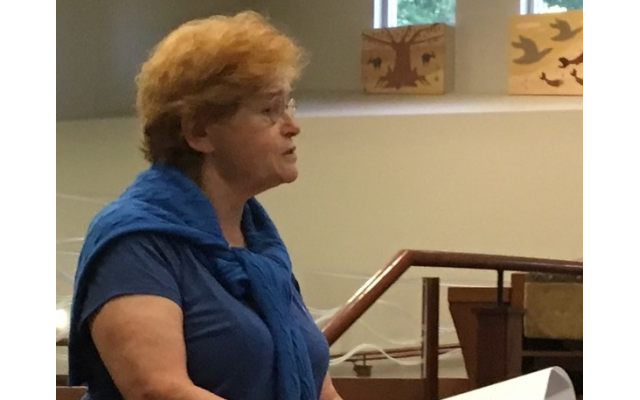Lipstadt Lectures on Anti-Semitism on Tisha B’Av
Deborah Lipstadt, the distinguished Holocaust scholar, spoke this week to discuss anti-Semitism and the new forms it can take.

Deborah Lipstadt came back to the synagogue in Toco Hills she left earlier this year in a dispute with the Young Israel national religious organization to once again sound the alarm about the rising tide of anti-Semitism in the world.
Lipstadt, a distinguished Holocaust scholar and Emory University professor of Jewish history, has spent the better part of the past year promoting the ideas in her new book, “Antisemitism Here and Now,” which was published in January.
Her message at the synagogue changing its name from Young Israel of Toco Hills to Congregation Ohr HaTorah was that the new anti-Semitism is in many respects much like the old anti-Semitism, rooted in the narrative of the New Testament that demonizes Jews for their rejection of the Christian messiah.
It is a scriptural tale, in her words, that accuses the Jews of using their superior intellect to crucify a troublesome Jewish rebel who criticized the money-changers of The Temple in Jerusalem.
“So it’s a story about money. It’s about intellect. It’s about power. All used nefariously. All used maliciously. So what happens is the Jew becomes not just someone you dislike, but someone you fear.”
The story reaches its most vicious expression, as Lipstadt explains it, in the Middle Ages where Christianity turns the Jew into a representative of the devil.
“The devil has two characteristics which fit right into this anti-Semitic template,” she maintained. “One characteristic is that you don’t recognize the devil until he has done his dirty work, and the other is that the devil has the power to harm G-d. The Jew becomes the enemy with incredible power to do harm.”
Lipstadt’s synagogue talk on Aug. 11 came at the conclusion of the solemn fast day of Tisha B’Av, which commemorates various past tragedies of the Jewish people.
But in an extraordinary coincidence, the fast fell two years to the day after one of the most significant anti-Semitic gatherings in recent memory, the marches in Charlottesville, Va., of August 11-12, 2017.
The ADL points out that since then white supremacists have committed at least 73 murders, 39 of them directly motivated by hate and racism. In places such as Parkland, Pittsburg, Poway and most recently in El Paso, the violence was largely inspired, in ADL’s view, by the events in Charlottesville.
“In each of these cities,” ADL noted, “white supremacist murderers acted on the threat embodied in the chant made famous in Charlottesville: ‘Jews will not replace us! You will not replace us!’”
It’s a simple chant with a complex message that Lipstadt explained more fully Sunday in her Tisha B’Av message.

“The people on the far right are motivated by something called replacement fear that is chanted as, ‘Jews will not replace us.’ According to white nationalists, it is another way of saying that there is underway a massive migration of black people and brown people and Muslims coming to take over the world, but these people are not smart enough or not talented enough to be doing this on their own. Someone is controlling that, and always, that is the Jews.”
So in Lipstadt’s view, today racism and violence is nothing new. Like old wine in new bottles, the hateful teachings of the past are alive once again.
Such a stereotype, reinforced by religious teachings, has had and continues to have a durable lifetime. Down through the ages, as Lipstadt describes it, anti-Semitism is like a piano on which different tunes can be played but the instrument remains the same.



comments